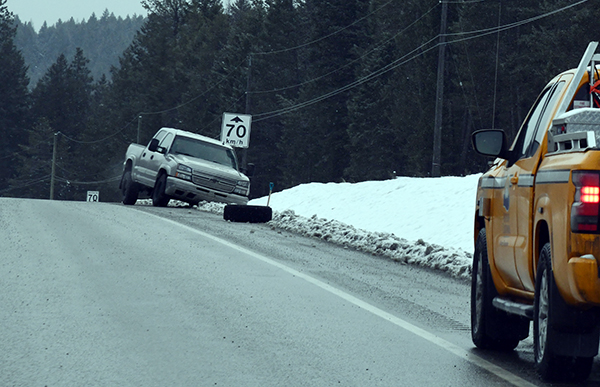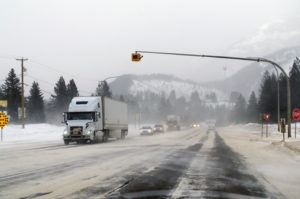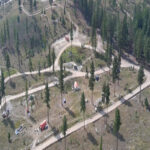Home »

The dangers of December driving
Holiday hustle, winter roads make it risky month behind wheel
December may be the most wonderful time of the year but it’s also one of the most dangerous times for drivers in B.C.
Over the last five years, an average of 25,993 crashes were reported to ICBC in the month. That works out to nearly 35 every hour. For people who drive as part of their job, WorkSafeBC statistics show workplace injury claims related to driving increase in winter by nearly 20%.
 “Holiday plans bring good cheer but they also bring more chances for things to go wrong on the road,” said Trace Acres, spokesperson for Road Safety at Work’s annual Winter Driving Safety campaign. “Whether you’re heading out for shopping or to see a client, the risks increase significantly.”
“Holiday plans bring good cheer but they also bring more chances for things to go wrong on the road,” said Trace Acres, spokesperson for Road Safety at Work’s annual Winter Driving Safety campaign. “Whether you’re heading out for shopping or to see a client, the risks increase significantly.”
The holiday rush kicks into high gear next week, which is also national Safe Driving Week (December 1 to 7). Making road safety a priority in December is essential because of the variety of factors that challenge even experienced drivers.
“Cold weather, wet roads, darkness, fatigue, and rushing to fit everything into a day all add up,” Acres said.
Many drivers assume winter risk refers only to snow. But traction can vanish long before flakes fall. When the temperature drops below 7C, the rubber in summer or all-season tires hardens, reducing grip and lengthening stopping distances. Winter-rated tires provide better performance.
“Anti-lock brakes and traction control can’t help if your tires can’t grip,” Acres said.
Winter-rated tires are mandatory on many B.C. highways during winter months.
Crashes can be prevented

Most crashes are preventable, even at this time of year. Road Safety at Work encourages everyone who drives — for personal reasons or on the job — to take some simple steps to keep themselves and their passengers safe:
- Plan ahead: Check conditions on DriveBC.ca and delay trips when weather or road conditions look poor.
- Slow down and leave space: Posted speed limits apply to ideal conditions. When roads are wet, dark, or icy, reduce speed and leave more room between yourself and the vehicle ahead. On highways, leave at least four seconds of following distance.
- Prepare your vehicle: Use winter-rated tires with at least 3.5 mm tread depth, make sure tires are properly inflated, and carry an emergency kit in case you’re stranded.
- Stay alert and focus on driving: Avoid fatigue by resting before long drives. Don’t use your phone while driving. Even hands-free operation can distract you.
“Safe driving is the gift everyone can give,” said Acres.
Driving for work is risky too
 Hundreds of thousands of British Columbians drive as part of their job, in all sectors. They travel to see clients, move between job sites, make deliveries, pick up supplies, provide mobile services, etc.
Hundreds of thousands of British Columbians drive as part of their job, in all sectors. They travel to see clients, move between job sites, make deliveries, pick up supplies, provide mobile services, etc.
“Every time an employee is on the road, even if it’s only for a few minutes, they’re at risk.” Vehicle crashes are the leading cause of traumatic work-related deaths in B.C.
By picking safer routes, scheduling more time for trips, and reminding employees to check conditions before leaving, employers can help protect their staff and avoid costly downtime.
“No deadline is worth putting lives at risk,” Acres said.
Whenever you drive on the job full time, part time, or occasionally, you need to follow your employer’s safe-driving policies. If you’re unsure, ask for instruction.
“Roadside workers spend long hours in cold, dangerous conditions to keep our roads safe, often working just feet from moving traffic,” said Jennifer Whiteside, Minister of Labour. “Their hard work and dedication make our communities run smoothly, but it puts them at real risk every day. This holiday season, slowing down, staying alert and respecting work zones is the best way to help workers get home safely to their families.”
Todd McDonald, Head of Prevention Services, WorkSafeBC added: “Winter driving demands more from all of us. With rain, snow, ice, and limited daylight working against drivers, the risk of serious crashes rises sharply this time of year. Employers play a critical role in ensuring workers understand how to assess driving hazards, plan safe routes and schedules, and ensure worker feedback is incorporated into safety procedures.
“When employers and workers work together, we can prevent injuries and keep everyone safe on the road.”
For more winter driving tips, visit RoadSafetyAtWork.ca/Winter.
| Region | Communities included | December crashes reported to ICBC (annual average from 2020-2024) |
| BC | Entire province. | 25,993 |
| Lower Mainland | Southwest corner of mainland BC, from Pemberton to Boston Bar, including Fraser Valley, Greater Vancouver, southern Sunshine Coast. | 16,760 |
| Southern Interior | Southern third of the province, including the Kamloops area, Okanagan and Kootenay regions, as far west as Boston Bar and Lillooet. | 3,929 |
| Vancouver Island | The Island, Gulf Islands, and Powell River. | 3,528 |
| North Central | Central Interior as far south as 100 Mile House, Peace River district, Prince Rupert, Haida Gwaii, and all points north. | 1,651 |
e-KNOW file photos
Road Safety at Work







